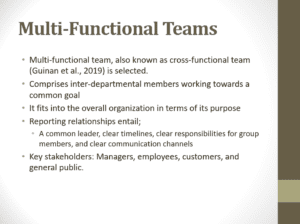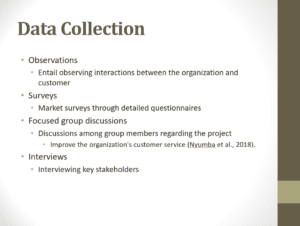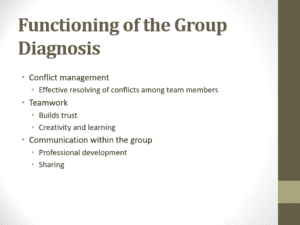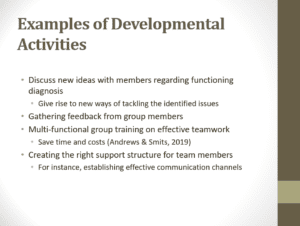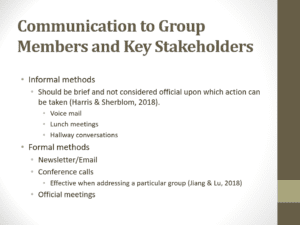Communication to Group Members and Key Stakeholders\
Hire our assignment writing services in case your assignment is devastating you.
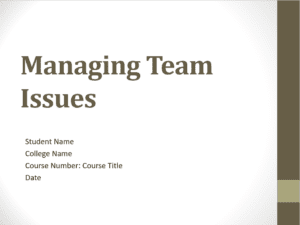
Multi-functional group, also known as a cross-functional group, is the selected work group within the organization (Guinan et al., 2019). The group comprises members from different organizational departments who come together to pursue a common goal. The specifically selected group will pursue the goal of developing a new customer care program. The program will entail customer care software that will ensure customer concerns are taken to account in time and given the required response. The team comprises members drawn from all departments in the organization, including the human resource department, operations, marketing, and finance. The group fits well into the overall organization in terms of its purpose. Notably, this is so because it draws its members from different departments in the organization. The members understand the organizational objectives well, which helps them steer the group goal toward organizational goals. Reporting relationships within the multi-functional group determine its success. The relationships are built on a single group leader overseeing the entire group’s functioning. Additionally, the group members embrace teamwork through effective work relationships built on clear member responsibilities and communication channels created among them. Regarding the key stakeholders, achieving the group goal will improve customer service and the overall organization’s working efficiency. Therefore, the primary stakeholders for the project are the organization managers, employees, customers, and the general public who encounter the organization in their environment.
Collecting data for the group project will be obtained through various methods. First, observations will be made on customer interactions and the organization acquiring products. Since the group project will be aimed at improving customer service through customer service software, the observations will be crucial to identifying key areas of attention. The second approach to collecting data for the group project will be a survey. The surveys will take the form of a questionnaire administered to key stakeholders regarding the organization’s customer service. Primarily, responses from customers will be taken seriously because they will inform the group project in the greatest part. The questionnaires will be sent to the targeted respondents through email, while other questionnaires will be delivered manually to visiting customers. Third, focused group discussions will be undertaken by the multi-functional group members. The discussions will unearth what the members think is important in improving the organization’s customer service (Nyumba et al., 2018). Additionally, they will suggest what to include in the software and what to exclude. Finally, interviews will be conducted with willing stakeholders regarding their view of the organization’s customer service. As a result, the group will allocate certain members the responsibility of planning interviews with identified stakeholders and conducting the interviews within the scheduled time.
The development plan will require both quantitative and qualitative data regarding various aspects. First, the plan will require budgeting and costing data regarding the new customer care software plan. This data includes forecasted expenditures to be incurred for the entire project. Notably, this information will ensure effective team management in delivering their mandates within the set boundaries. Second, the development plan will require data relating to the evaluation strategy. The evaluation strategy includes the project’s intended outcomes, impacts, and success measurement indicators. Third, data relating to the project timeline and deliverables will be required based on the timelines. Essentially, the data will ensure effective monitoring of group functioning within the scheduled time limits. Fourth, each member’s roles and responsibilities will inform the data required for the development plan. Assigning each member a given role and responsibilities will ensure seamless working with fewer collisions and, thus, effective delivery of the development plan. Fifth, the development plan will require information on the project goals and how they will be delivered. Finally, the development plan will require information relating to risk and risk assessment. Notably, this data is important because it can hinder the team from accomplishing the set objectives. Therefore, having the data will ensure risk mitigation measures are taken to prevent events that can hinder the achievement of a group project.
Effective functioning of the multi-functional group is essential to achieving its set goals and objectives. Therefore, there are different ways in which the group’s functioning will be diagnosed. First, the group will be diagnosed with conflict management. Effective groups have an efficient conflict management procedure and ensure all members work harmoniously. Problems among group members that are difficult to resolve to the extent of hindering them from performing their functions will be identified. As a result, the problem will be diagnosed, and an effective conflict management procedure will be suggested to the group. Second, the group functionality will be diagnosed in line with teamwork among the team members. An effective team is characterized by a high level of teamwork, which enhances faster and more efficient achievement of team goals. When a group has high-level teamwork, trust is built among its members. Further, there will be creativity and learning, which is important for the group’s success. Thus, a lack of these aspects in the group will indicate a group that is not fully functional, and measures to correct the situation will be required. Finally, a well-functioning group will exhibit effective communication among its members, indicated by sharing and professional development of each member.
Four identified examples of developmental activities that can be used for various levels of functioning are based on the diagnosis done. The first example is the discussion of new ideas with members regarding the performed diagnosis. The discussions will give rise to new ways of tackling the identified issues. Further, the discussion makes the members part of the problem-solving; thus, they will willingly participate in resolving the issues. The second example entails collecting feedback from team members. Notably, this example is different from the first one in that the collected feedback is worked upon without the involvement of the team members. In the third example, team members will be trained in effective teamwork. Regarding this training, the organization will train all team members on handling issues that might arise while fulfilling their functions. Upon the occurrence of the issues identified in the diagnosis, the members will respond effectively without requesting help from any support authorities, which in turn will save time and costs (Andrews & Smits, 2019). The last developmental example relates to creating the right support structure for team members to address issues that influence them while undertaking their responsibilities. For instance, establishing effective communication channels will ensure all matters arising in work are communicated to the right place for the right responses to be achieved.
Communication with group members and key stakeholders can be done through both formal and informal methods. Regarding the informal methods, communication can be done through lunch meetings, voice mails, and hallway conversations. It is important to note that communication through informal meetings should be brief and should not be considered official discussions from the group management upon which action can be taken (Harris & Sherblom, 2018). Such communication should be informatory and used to air and collect views regarding the group’s progress. On the part of formal communication, more attention is required. Notably, this is so because communication can be used to hold the team responsible for any commitments made using formal communication methods. The first communication method under this category is the group’s newsletter or emails sent to stakeholders and group members. They can rely on information from this source to make investment decisions. Conference calls are the second formal communication method involving key stakeholders and group members. It is worth noting that this method is effective when addressing a particular group, such as departmental team members or a given section of key stakeholders (Jiang & Lu, 2018). The method allows each member to contribute to the conversation. Finally, the team leader can make communication through official meetings.
ORDER A PLAGIARISM-FREE PAPER HERE
We’ll write everything from scratch
Question
Assignment Description
A key component of an effective workplace is the ability of the groups to successfully collaborate. Choose a work group within your organization. Using a model of organizational improvement, plan a development project for this group. Include responses to the following in your presentation:
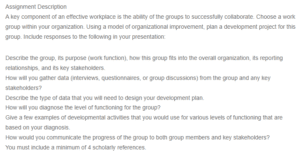
Communication to Group Members and Key Stakeholders
Describe the group, its purpose (work function), how this group fits into the overall organization, its reporting relationships, and its key stakeholders.
How will you gather data (interviews, questionnaires, or group discussions) from the group and any key stakeholders?
Describe the type of data that you will need to design your development plan.
How will you diagnose the level of functioning for the group?
Give a few examples of developmental activities that you would use for various levels of functioning that are based on your diagnosis.
How would you communicate the progress of the group to both group members and key stakeholders?
You must include a minimum of 4 scholarly references.

